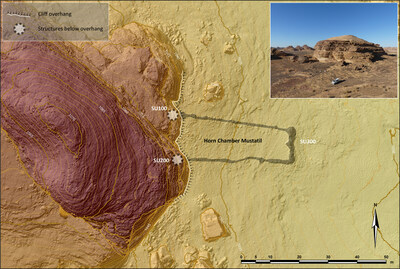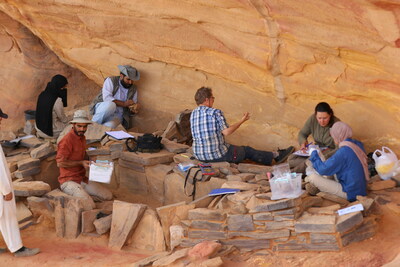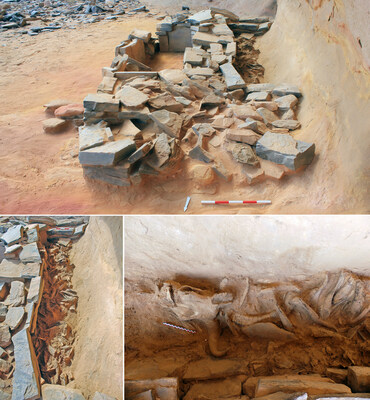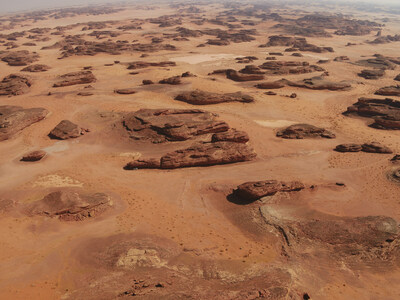7,000-year-old animal bones, human remains found in enigmatic stone structure in Arabia | Live Science
Archaeologists are uncovering evidence of religious rituals in Norther Arabia, 3000 years before creationists believe Earth and humans were created!
Creationists love to point to the fact that all cultures, ancient and modern, tend to have religion as a central element to the culture, as though that fact somehow proves the locally popular god is real.
Of course, it also points to the fact that we have evolved to 'fail safe' and assume agency where there is none, to naively believe what our parents believe, to accept simplistic answers to complex questions and find it impossible to imagine total oblivion at death.
But, ask a creationists to explain why we should accept the locally popular god is the only real one and all the ancient gods are false, and they will probably cite much of that list as reasons why they had false beliefs, stopping short of going just one god (or one pantheon) further and applying that logic to their own god(s), citing all sorts of nebulous reasons why they believe in their particular god(s).

Did the sun not rise in the morning because they had performed the right rituals? Did the crops not fail when they had failed to chant the right prayers in exactly the right way at the right time, or had broken the rules in some other way?
Did the gods not reward them by helping them prevail in battle or punish them for an assumed transgression when they lost a battle?
And could they too not 'look at the trees' and marvel at the wonders their gods had created? And did their priests not also have the power of prophesy and claim they heard the god(s) speaking to them?
One thing we can be sure about is that belief in their god(s) was a strong motivation for rituals associated with life, death and probably animal husbandry, as it is for believers today. The evidence for that is in the artifacts they left behind as discovered by archaeology, such as that currently going on at al Ula in the Ashar Valley in Northern Arabia, where researchers have now discovered evidence of ritual sacrifice and burials in the remains of stone structures known as mustatils, which are believed to have been used for religious purposes.
To add to the embarrassment for creationists, these structures have been dated to about 7,000 years ago, i.e., some 3,000 years before Earth and humans were created!
Regular readers may recall how the archaeological site in Northern Arabia, close to the Fertile Crescent was the subject of a blog post here last March. Now the Royal Commission for AlUla (RCA), set up to investigate the site, has produced an update. It concerns the remain, both animal and human, found in some of the graves associated with the buildings.
As the RCA news release reports:
Results of two recent archaeological excavations supported by the Royal Commission for AlUla (RCU) demonstrate that the Neolithic inhabitants of north-west Arabia conducted "complex and sophisticated ritual practices" in the late 6th millennium BCE.The standard excuse for discoveries like this that refute basic creationists beliefs is that the dating method the archaeologists used was flawed and made 2,000 years look like 7,000 years. So, I hereby invite any creationist apologist to say:
The unprecedented findings open unsuspected horizons for a broader understanding of the social, cultural and spiritual background of the ancient peoples of north-west Arabia.
Researchers emphasise the probable communal character of the ritual and the possibility that people journeyed specifically to prehistoric stone structures known as mustatils to undertake the ritual, which would represent one of the earliest known pilgrimage traditions. Further, greater representation of domestic species among the animal offerings confirms the pastoral nomadic nature of the community, whose members may have built the mustatils as a form of social bonding and/or a marker of territory.
Mustatils are large-scale, open-air rectangular structures with low stone walls. Through aerial surveys, researchers have identified more than 1,600 of them across north Arabia. Though the structures' function was at first unknown, excavations since 2018 have pointed to a ritual significance and provided increasing insights into the practice.The outline of the Kennedy team’s mustatil is at the forefront of this image of the landscape east of AlUla. They describe the location as “essentially hidden in the sandstone canyons”.Credit: Hugh Kennedy, AAKSA / RCU In this overview of the Horn Chamber Mustatil (at IDIHA-0000687), SU300 marks the eastern wall of the mustatil, SU200 marks a stone cairn and SU100 marks the 7x2.5m platform containing the horn chamber. The cliff overhang protected the horn chamber from exposure to the elements, which accounts for the exceptional state of preservation.Credit: Wael Abu-Azizeh et al 2022 / RCU
In this overview of the Horn Chamber Mustatil (at IDIHA-0000687), SU300 marks the eastern wall of the mustatil, SU200 marks a stone cairn and SU100 marks the 7x2.5m platform containing the horn chamber. The cliff overhang protected the horn chamber from exposure to the elements, which accounts for the exceptional state of preservation.Credit: Wael Abu-Azizeh et al 2022 / RCU
Results of the two studies have been peer-reviewed and recently published. The study led by Dr Wael Abu-Azizeh of the Archéorient Laboratory and France's Lyon 2 University appears in the book "Revealing Cultural Landscapes in North-West Arabia," edited by a team of experts led by Dr Rebecca Foote, Director of Archaeology at RCU. The study led by Dr Melissa Kennedy of Australia's University of Sydney appeared in the journal PLoS One in March.
Abu-Azizeh study
In 2018 Dr Abu-Azizeh began an excavation on behalf of Oxford Archaeology that unearthed the "Horn Chamber" in a mustatil at site IDIHA-0000687 north-east of AlUla dating to circa 5300-5000 BCE. The chamber measures 3.25m by 0.8m and is at the western end of a mustatil measuring 40x12 metres – smaller than most mustatils.
Inside the "Horn Chamber" he and his team made an exceptional discovery of horns and skull fragments, densely packed into a layer 20 to 30cm deep that covered the floor of the chamber. This, they write, is "a unique and unprecedented assemblage in the context of north Arabian Neolithic."
About 95% of the horns and skull fragments were from domestic species – goat, sheep and cattle – with the rest from wild species including gazelle, Nubian ibex and aurochs (a now-extinct ancestor of domestic cattle). Beneath the assemblage was a thin bedding of twigs that in preparation for the ritual had been placed on the chamber's sandstone surface.
The researchers conclude that the horns and skull fragments were probably deposited during a single ceremony. In a tentative reconstruction of the ritual, they propose that pastoral nomads gathered and bore the offerings as part of the ritual performance. To reach the solemn space of the small Horn Chamber they entered one by one through a narrow doorway and small antechamber with hearths to present this trophy on behalf of their social group. The collective hoard of enshrined offerings expressed a cohesive identity for the wider social group.
The researchers write:Kennedy studyBy the quantity of remains, the diversity of species represented, and the unusual state of preservation, this assemblage constitutes a unique and unprecedented discovery in the archaeological record of the region. This deposit is interpreted as a testimony of complex and sophisticated ritual practices…
In 2019, the second study, by a team led by Dr Kennedy, then of the University of Western Australia, began excavation of a mustatil deep within dense sandstone canyons east of AlUla, at site IDIHA-0008222. Like Abu-Azizeh's team, they found a chamber containing horns and skull parts that dated to circa 5200-5000 BCE, though not in as great a quantity. There are further differences: these bones appeared to have been deposited in three or four phases over a generation or two, rather than all at once.
Most of the horns and skull parts were from cattle, and several from goats. The researchers write that this finding isamongst the earliest attestation of domestic cattle and goat in northern Arabia.
At the centre of the shrine is an upright stone that is believed to have served as the focal point for the ritual. Most of the horns and skull parts were deposited around this standing stone, which stood 0.8m high. The researchers interpret this stone as being a betyl,This would constitute one of the earliest known betyls in the Arabian Peninsula.a mediator between humankind and the divine, acting as a proxy or a manifestation of an unknown Neolithic deity/deities or religious idea, to which the faunal elements were deposited as votive offerings.
The researchers further note that the repeated used of the shrine over a period of yearsrepresents one of the earliest examples of 'pilgrimage' or shrine revisiting currently identified in the Arabian Peninsula.
Intriguingly, they hypothesise that the placement of the mustatils might have had an ecological basis. The Arabian climate was growing more arid in the Middle Holocene Period; varying micro-climates made mobility essential and herding viable. The ritual might have been intended to ensure fertility and the continuity of rains, with the mustatils themselves possibly located near water sources such as wadis. This, the writers say, is a key avenue for future research.
AlUla World Archaeology Summit
AlUla's position as a hub of archaeological activity will continue to expand, as RCU will host the inaugural AlUla World Archaeology Summit taking place from Sept 13-15, 2023.
The Summit is a platform for advancing archaeology and cultural heritage management in their interface with other disciplines. This gathering of leaders from academia, government, non-government organizations, industry, and young people representing the next generation of archaeologists will not only enrich the archaeological community and help protect shared history but also open up a larger reflection of what and how archaeology, and more broadly cultural heritage, can contribute to transformational changes in society.RCU has embarked on one of the largest archaeological research programmes worldwide. Across AlUla and Khaybar, 12 current surveys, excavations and specialist projects are deepening our understanding of the past environment, land use, and human occupation of the region. Rich cultural landscapes are being revealed, including funerary avenues, mustatils, ancient cities, inscriptions in 10 languages, rock art and complex agricultural practices. AlUla is a leading hub of archaeological activity, a standing that will be enhanced by the inaugural AlUla World Archaeology Summit.
Dr Rebecca Foote
Director of Archaeology and Cultural Heritage Research at RCU
- Which dating method did these archaeologists use?
- How was it flawed, and allowing for the assumed errors, what should the correct date have been?"






No comments :
Post a Comment
Obscene, threatening or obnoxious messages, preaching, abuse and spam will be removed, as will anything by known Internet trolls and stalkers, by known sock-puppet accounts and anything not connected with the post,
A claim made without evidence can be dismissed without evidence. Remember: your opinion is not an established fact unless corroborated.